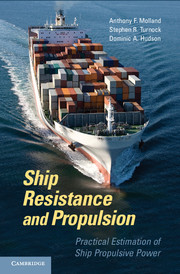Book contents
- Frontmatter
- Contents
- Preface
- Nomenclature
- Abbreviations
- Figure Acknowledgements
- 1 Introduction
- 2 Propulsive Power
- 3 Components of Hull Resistance
- 4 Model-Ship Extrapolation
- 5 Model-Ship Correlation
- 6 Restricted Water Depth and Breadth
- 7 Measurement of Resistance Components
- 8 Wake and Thrust Deduction
- 9 Numerical Estimation of Ship Resistance
- 10 Resistance Design Data
- 11 Propulsor Types
- 12 Propeller Characteristics
- 13 Powering Process
- 14 Hull Form Design
- 15 Numerical Methods for Propeller Analysis
- 16 Propulsor Design Data
- 17 Applications
- Appendix A1 Background Physics
- Appendix A2 Derivation of Eggers Formula for Wave Resistance
- Appendix A3 Tabulations of Resistance Design Data
- Appendix A4 Tabulations of Propulsor Design Data
- Index
- References
1 - Introduction
Published online by Cambridge University Press: 07 September 2011
- Frontmatter
- Contents
- Preface
- Nomenclature
- Abbreviations
- Figure Acknowledgements
- 1 Introduction
- 2 Propulsive Power
- 3 Components of Hull Resistance
- 4 Model-Ship Extrapolation
- 5 Model-Ship Correlation
- 6 Restricted Water Depth and Breadth
- 7 Measurement of Resistance Components
- 8 Wake and Thrust Deduction
- 9 Numerical Estimation of Ship Resistance
- 10 Resistance Design Data
- 11 Propulsor Types
- 12 Propeller Characteristics
- 13 Powering Process
- 14 Hull Form Design
- 15 Numerical Methods for Propeller Analysis
- 16 Propulsor Design Data
- 17 Applications
- Appendix A1 Background Physics
- Appendix A2 Derivation of Eggers Formula for Wave Resistance
- Appendix A3 Tabulations of Resistance Design Data
- Appendix A4 Tabulations of Propulsor Design Data
- Index
- References
Summary
The estimation of ship propulsive power is fundamental to the process of designing and operating a ship. A knowledge of the propulsive power enables the size and mass of the propulsion engines to be established and estimates made of the fuel consumption and operating costs. The estimation of power entails the use of experimental techniques, numerical methods and theoretical analysis for the various aspects of the powering problem. The requirement for this stems from the need to determine the correct match between the installed power and the ship hull form during the design process. An understanding of ship resistance and propulsion derives from the fundamental behaviour of fluid flow. The complexity inherent in ship hydrodynamic design arises from the challenges of scaling from practical model sizes and the unsteady flow interactions between the viscous ship boundary layer, the generated free-surface wave system and a propulsor operating in a spatially varying inflow.
Up to the early 1860s, little was really understood about ship resistance and many of the ideas on powering at that time were erroneous. Propeller design was very much a question of trial and error. The power installed in ships was often wrong and it was clear that there was a need for a method of estimating the power to be installed in order to attain a certain speed.
- Type
- Chapter
- Information
- Ship Resistance and PropulsionPractical Estimation of Propulsive Power, pp. 1 - 6Publisher: Cambridge University PressPrint publication year: 2011



